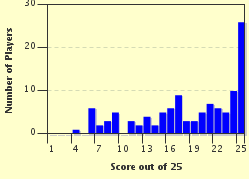Quiz Answer Key and Fun Facts
1. Australian PM #1 (Barton, 1901-1903): Australia's first Prime Minister, Edmund Barton, only served just over two and a half years of his term, which began on 1 January 1901. Why did he leave office in September 1903?
2. Australian PM #2 (Deakin, 1903-1904; 1905-1908; 1909-1910). Alfred Deakin was not only Australia's second PM, but also its 5th and 7th. This makes him the only PM from 1901-2012 who has served as Prime Minister on more than one non-consecutive occasion.
3. Australian PM #3 (Watson, April-August 1904). Chris Watson was Australia's first Prime Minister representing which party?
4. Australian PM #4 (Reid, 1904-1905). George Reid was the first former state premier to become Prime Minister. Which state did he lead before taking his national office?
5. Australian PM #5 (Fisher, 1908-1909 and 1910-1913). Andrew Fisher's Prime Ministership came to an end due to the formation of which new party in 1908?
6. Australian PM #6 (Cook, 1913-1914). What major world event had a significant impact on Joseph Cook's Prime Ministership?
7. Australian PM #7 (Hughes, 1915-1923). Billy Hughes signed the first treaty on Australia's behalf. Which famous treaty associated with the end of World War I was it?
8. Australian PM #8 (Bruce, 1923-1929). Stanley Bruce shared his middle name with an Australian capital city. Which one?
9. Australian PM #9 (Scullin, 1929-1932). James Scullin was a victim of poor timing. Which event occurred just two days into his Prime Ministership?
10. Australian PM #10 and #11 (Lyons, 1932-1939; and Page, 1939, caretaker). Joseph Lyons was the first Prime Minister from which state?
11. Australian PM #12 (Menzies, 1939-1941; and 1949-1966). How did Robert Menzies' very long Prime Ministerial career of 18 years come to an end?
12. Australian PM #13 (Fadden, 1941). Arthur Fadden served as leader of which political party during his brief Prime Ministership, which was later to form the Coalition along with the Liberal Party?
13. Australian PM #14 and #15 (Curtin, 1941-1945; and Forde, caretaker, 1945). Despite serving over 4 years as Prime Minister, John Curtin never contested a federal election.
14. Australian PM #16 (Chifley, 1945-1949). Which major infrastructure project did Ben Chifley preside over the commencement of during his term?
15. Australian PM #17 (Holt, 1966-1967). Harold Holt is no doubt most famous for disappearing during a morning swim off Portsea Beach in 1967 and never being seen again. He did preside over some major events in Australia's history in his 22 month term. Which of these was NOT one of them?
16. Australian PM #18 (McEwen, Dec 1967-Jan 1968). John McEwen served as caretaker when Holt disappeared, but when his successor was chosen he was given an important role in the new government. Which?
17. Australian PM #19 (Gorton, 1968-1971). John Gorton was not elected from the House of Representatives as every Prime Minister before him. He was the first to be elected from what other house of parliament?
18. Australian PM #20 (McMahon, 1971-1972). What was William McMahon's nickname?
19. Australian PM #21 (Whitlam, 1972-1975). The end of Gough Whitlam's term is almost certainly the best known aspect of his Prime Ministership. However, he did accomplish many changes in his nearly 3 year term. Which of these is NOT one of them?
20. Australian PM #22 (Fraser, 1975-1983). Although known as Malcolm, what was Fraser's given name at birth?
21. Australian PM #23 (Hawke, 1983-1991). Why did Bob Hawke resign in 1991?
22. Australian PM #24 (Keating, 1991-1996). How did Paul Keating describe the early 1990s recession in Australia?
23. Australian PM #25 (Howard, 1996-2007). What did John Howard name his amended industrial relations legislation, introduced in 2006 to take advantage of a Liberal Senate majority?
24. Australian PM #26 (Rudd, 2007-2010). Which historical event occurred at Parliament House under Kevin Rudd's government on 13 February 2008?
25. Australian PM #27 (Gillard, became PM in June 2010). Apart from being the first female Prime Minister of Australia, Julia Gillard was also the first PM to fit into which category?
Source: Author
timence
This quiz was reviewed by FunTrivia editor
stedman before going online.
Any errors found in FunTrivia content are routinely corrected through our feedback system.

